Loving and learning from cats

Loving and learning from cats
A four-professor roundtable discussion about cats and UTokyo,
covering literature, history, veterinary medicine and trivia
"Feline" faculty forum
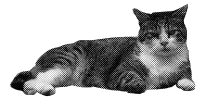
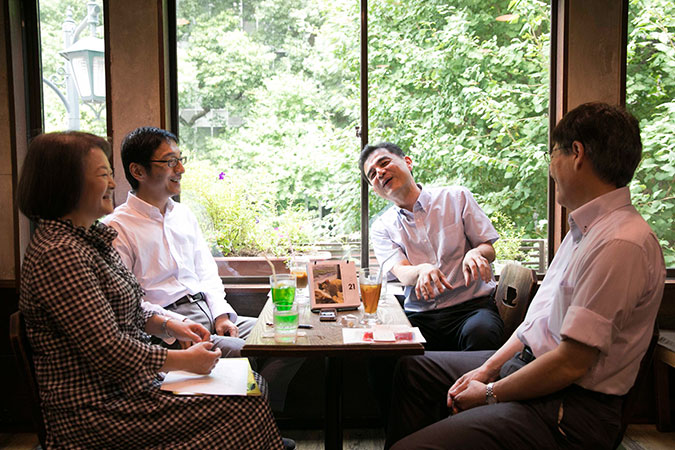
For the special discussion in this cat-themed edition of Tansei, we brought together four professors to talk about their love of cats. The discussion took place on the second floor of a café in Hongo which has long had a connection with cats. Personalities and instincts of cats, cats across history, cats in literature, cats on campus, cats in affairs both foreign and domestic, and even cats as aromas ...?! With endless topics about cats, this became the most smile-filled special discussion in the history of Tansei.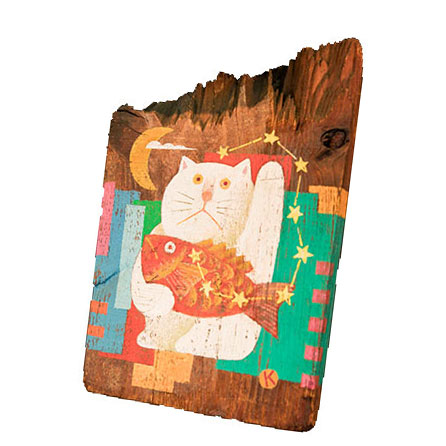
- Suda: First of all, everyone, please tell us about your relationship with cats.
- Nishimura: I treat cats at the surgical department of the Veterinary Medical Center; in fact, I was just treating one earlier today. I am also a cat owner.
- Nozaki: I had a dog when I was a child, so I actually used to be a dog person. I found a mummified cat under the floor of an old house one time so I always had a strange impression of cats. But I’ve since converted into a cat person.
Love for cats awakened by a nightly knocking
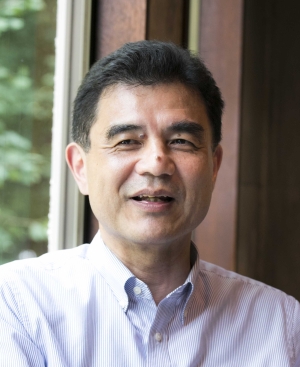
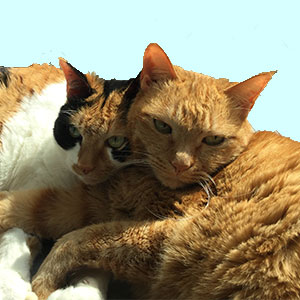
They served as feline blood donors at a veterinary clinic before they were taken in by the Nishimura household.
- Suda: What made you convert?
- Nozaki: Roughly 30 years ago, when I started living in a Hitotsubashi University dormitory, I heard knocking on my door. I opened the door but no one was there. This continued for a few nights, until one night, I opened the door and there were three cats right outside. They were strays that the previous tenant used to feed. From there I was moved by their affection and started feeding them. That was my awakening. Thereafter, my wife was given a rescue cat which lived with us for 20 years – it passed away a few years ago. We are still affected by that. Also, I have a faint memory from when I was relocated to Komaba – I was nervously walking around the campus for the first time when I came across a “Komaneko” (Komaba Campus cat) which led me into Building 8.
- Hongo: There were always cats in my home. After I got married, I took in an abandoned cat which lived with us for 17 years but it went missing one day – we were deeply saddened by that, but now we have a rescue cat that we took in this past January. I’ve also brought in a cat I found on the UTokyo campus. During my first year working here, I came across a white cat in the middle of the road in a daze. My husband-to-be and I picked it up and took it home with us.
- Suda: For me, my wife loved cats and she was always saying she wanted one, so we went to a pet shop where we encountered a Somali cat – it was love at first sight and we have had it for eight years now. It doesn’t jump onto my lap or come into the bed, but it does like to snuggle next to me when I’m taking a nap.
- Nozaki: Now that I think about it, I feel like cats may have not liked the way I have shown affection to them. They’d bite me while I cuddled them, which I thought was a sign of friendship, but perhaps it really meant that they didn’t like me …
- Nishimura: There are many cats that don’t like being cuddled.
- Suda: It seems as though dogs observe people and think about how to please them, but cats are different. Perhaps cats don’t have that ability. I feel like people have to adjust to cats, more so than the other way around.
- Nishimura: Dogs are probably more intelligent. Also, dogs recognize their food when you point at it, but other animals don’t. I think dogs and people have a special relationship.
- Nozaki: People and dogs can form a straightforward relationship right from the beginning. That is one of the wonderful things about dogs that I noticed when I was a child. With cats, there are things that are hard to explain, all of which I find thrilling. Perhaps they have a prescription that works against humans …
- Nishimura: With any animal, staring at each other is a sign of aggression, but this isn’t the case for dogs and people. When you gaze at a cat, though, it looks away.
- Nozaki: That reminds me – my cat made a strange noise to tell me off when I was staring at it.
- Suda: My cat makes eye contact …
- Nozaki: Dogs’ appearances change a lot as they grow up, but I feel like cats stay more or less the same.
- Hongo: Dogs’ faces get long as they age.
- Nishimura: That seems to be one of the reasons why people love cats.
- Hongo: Because maybe they don’t mature that much.
- Nishimura: Speaking of growth, having pets is helpful for child development.
- Nozaki: When I had a child, I was worried about whether they’d get along with our cat. Some even say do not leave your cat near your baby, but in actuality our cat was always watching over the baby. I was very touched.
- Nishimura: It may be good to have a cat watch over students, too.
- Nozaki: We kept our cat indoors for 20 years, but I sometimes think that I should have let it play freely outside. Or that the cat may have had more fun if we had kept multiple cats in the house.
- Nishimura: Cats are fundamentally independent animals. In the past, it was normal to let them go back and forth between the house and outdoors, but now it has become apparent that keeping them indoors extends their life expectancy. It’s difficult to say which cats prefer. If I were to let my cat outside, it would probably get frightened and come back. Perhaps cats are in the midst of an evolutionary phase.
- Suda: I also had a dog in my family home, so when we got a cat, I was worried about whether it’d be all right indoors, closed off from the outside world. It doesn’t seem to be stressed, though.
- Hongo: My previous cat used to go in and out freely, but the one we have now is scared of going outside, perhaps because it was raised in a cage in an animal shelter.
- Nozaki: When I returned from my overseas business trip during my dorm days, the cat I was looking after went missing so I was worried and went searching. When I found the cat, it was getting fed in another home and was called by a different name. That is the strength of outdoor cats.
- Nishimura: Cats have long lived alongside humans in this manner. This transition towards keeping cats indoors completely must be a new phenomenon in the history of cats.
- Nozaki: I see. Maybe we are witnessing a historic turning point for cats.
A little wildness gives them a lot of charm
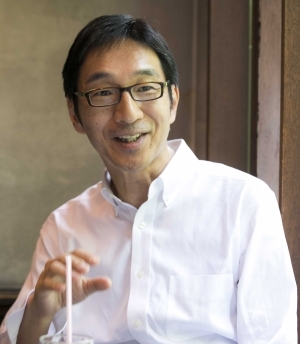
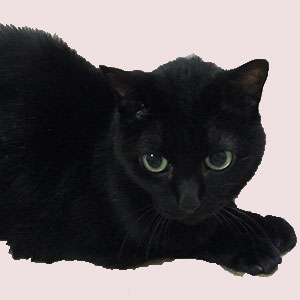
Its name comes from Coco Chanel, who was a master of black clothing.
- Nozaki: The wild side of cats is certainly charming, but for a period of time I was concerned as mine started jumping off from the top of my bookshelf for fun, landing on top of my computer and sharpening its claws there …
- Nishimura: I had already taken into consideration that my cat would go on top of a warm computer, but one time, it knocked my computer off the desk and to the floor. As a result, I lost all the documents I had prepared for an academic conference. My cat and I had a tense relationship for a week or so thereafter. Losing all the data right before a conference was painful.
- Suda: They do that kind of thing to get attention from people.
- Nozaki: They want to get in the way when people are concentrating.
- Nishimura: They only want attention when they want it.
- Hongo: Mine always gets on top of the newspaper as soon as I open it.
- Nozaki: There is a part of me that finds their wildness and rebelliousness exhilarating. Perhaps they do it on behalf of their owners who can’t behave in such a way.
- Hongo: My cat is a black cat. Black cats and calico cats are the least popular at cat shelters and don’t get offers – in which case, I thought, I would take one home with me. It’s often said that black cats are bad luck and calico cats are too clever.
- Nozaki: I heard that black cats are intelligent, too.
- Nishimura: There seems to be research on fur color and personality, but I think it is hard to determine personalities of cats. Research on dogs is more advanced, such as which types of dogs are better suited to becoming guide dogs.
- Hongo: I see; dogs are useful so they’re more likely to be researched. I feel like it would be useless to research cats.
- Suda: It would probably be beneficial to know which cats have good personalities and won’t go around destroying computers.
- Nozaki: I want cats to have a little wildness.
- Nishimura: I wouldn’t want a cat that is obedient like a dog.
- Nozaki: Although I do deeply admire the dedication of guide dogs.
- Hongo: Let’s tell our cats to follow their example.
- Nishimura: But something spectacular may arise from their uselessness.
- Nozaki: That seems like something that could apply to academia, too.
Awarding ranks to cats out of love
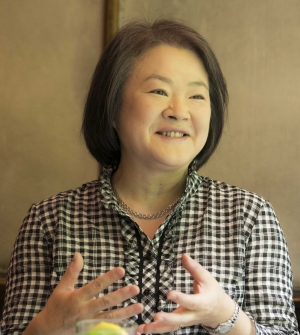
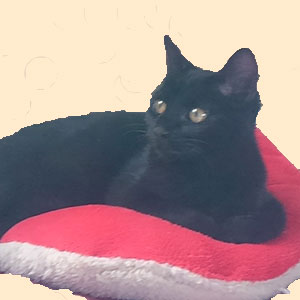
For her cat’s name, Professor Hongo chose a place name ending with “to” in order to match her husband’s and her child’s name, which also end with “to.”
- Nozaki: Where do cats show up in Japanese history?
- Hongo: In Sei Shonagon’s The Pillow Book, there is a cat that Emperor Ichijo was fond of. Since no one without court rank was admitted to the royal quarters in the palace, the cat was awarded fifth court rank. A story about the same cat appears in a noble’s diary; apparently, they held a ceremony to celebrate the birth of the cat’s kittens, which the powerful nobleman Fujiwara no Michinaga attended.
- Nozaki: It’s amazing that the Emperor gave a cat a court rank in order to love on it. Definitely more progressive than Europe – as far as I know, the status of cats declined as the Catholic Church grew stronger. Cats represented laziness, vice and greed, and didn’t have an affirmative presence in the arts either. I didn’t know that cats in Japan were treated in such a different way around the same time.
- Hongo: There are tales of beings like nekomata (mythical cat monsters) too, though.
- Nozaki: In Europe, cats have been victims of calamities due to their association with witches. For someone who loves black cats, Edgar Allan Poe’s “The Black Cat” is unforgivable. People’s negative impressions of black cats were ingrained by that piece. Poe was a great writer, but it was probably because of that story that he was miserable in his final years. Conversely, I feel like the prosperity of the Heian nobility culture was connected to cats. It’s only natural that the useless, unpredictable and mysterious nature of cats is closely linked to literature.
- Hongo: Is it an indication of preference to imported goods to call good cats karaneko, meaning “cat imported from China”? In Fujiwara no Teika’s diary, there are stories of an imported parrot and a civet (catlike mammal). He writes that the parrot is supposed to sing but it doesn’t, and that the civet isn’t particularly interesting.
- Nozaki: I wonder if the civet smelled nice. *1 The cat I had certainly did. In her bloom of youth, I buried my face in her fur and enjoyed its jasmine-like scent. Her sweet fragrance was so unforgettable that I even wrote an essay titled “Neko no Kaori” (“Scent of Cats”).
- Nishimura: … This is the first time I’ve heard about cats smelling nice.
- Suda: Perhaps it has to do with the change in their hormone secretion in accordance with the seasons? Mine has been neutered so maybe she doesn’t do that.
- Hongo: There were definitely times when mine smelled bad …
- Nozaki: Well, this is shocking. I just exposed my unusual proclivities to everyone.
- Suda: Maybe you have a similar sense of smell to cats, Professor Nozaki. You could thrive as a “cat sommelier,” examining cats by their smell.
- Nozaki: Oh, dear (laughs). In Europe, there are stories of pet cats in monasteries. Cats and religion didn’t really have a good relationship, as it was thought that the tendency of becoming too fond of cats led to attachment, in turn leading people to forget about God. In Yukio Mishima’s The Temple of the Golden Pavilion, there is a story about monks in training who fight over a cat, with the cat ending up sliced in two in a single stroke.*2 It could be said that there is substantial religious evidence backing up people’s fondness for cats.
- Hongo: It is because of the uselessness of cats that such pure love exists for them.
- Nozaki: Their beautiful fur has functionality.
- Nishimura: And smell (laughs).
- Nozaki: In France, as the practice of keeping cats indoors became commonplace in modern times, poets have praised the beauty of cats and literature has grown richer. From the Romantic era onwards, one cannot talk about the arts without mentioning cats. There aren’t any masterpieces depicting dogs in France, but cats are considered aesthetic subjects. In Catholicism, there is an ideology that when you get too attached to something created by God, you become separated from God. The trend of being freed from Catholicism and loving God’s creations can be felt through cats. Was it after the Edo period that love for cats spread in Japan?
- Suda: It must have been after things became peaceful.
- Nishimura: Cats often appear in ukiyo-e woodblock prints, but they all have short tails. Short-tailed cats seem to have been popular in the Edo period. They were brought in from Southeast Asia around that time, which is why there are still a lot of short-tailed cats in Nagasaki. Also, there is a theory that if a cat’s tail is short, it won’t turn into a nekomata, and that it therefore brings good luck.
- Hongo: Long tails seem more cat-like, though.
- Suda: It’s nice when cats come towards you with their long tails pointed up.
- Nozaki: Impressionist artists were influenced by ukiyo-e. There is a lithograph by Manet that depicts the romance of two cats on an apartment rooftop. Their tails are very long, while the cats that appear in ukiyo-e have short tails.
UTokyo campuses and cats

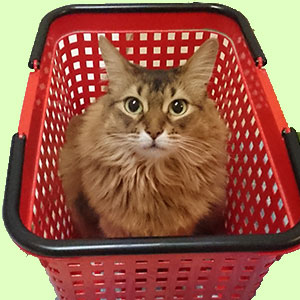
Its name comes from the color of its fur. It is a Somali cat of the long-haired Abyssinian breed.
- Nishimura: I live in Nezu where there are still a lot of stray cats. If you come to a certain place at a particular time and watch, you will see them there.
- Nozaki: I think we could do with more cats on the UTokyo campuses, too.
- Hongo: Back in the day, they used to come up to me as I walked under the shade of trees.
- Suda: There was a cat map of Hongo Campus published in a 1996 issue of Todai Shimbun (The University of Tokyo Newspaper).*3 Cats seem to have been everywhere at the time according to the map.
- Nishimura: You can still find them on Yayoi Campus.
- Nozaki: Perhaps I should go home via the Faculty of Agriculture (on Yayoi Campus) if that’s the case.
- Nishimura: This is just a thought, but it would be good if some UTokyo students were cat-like – students who are completely useless, but amazing at the same time.
- Hongo: Recently, it seems like there are a lot of dog-like members among the faculty. The type that are obedient and follow orders.
- Nishimura: Having cat-like faculty wouldn’t work out very well.
- Nozaki: They wouldn’t turn up to lessons, for instance. In that case, maybe we are dog-like.
- Nishimura: Maybe we admire how free cats are as an act of rebellion.
- Suda: We need cat-like people, too.
- Nishimura: It’s dangerous for everyone to face the same direction.
- Suda: We should have cat-like values for diversity’s sake, too.
- Nozaki: I think neighborhoods and universities where cats can roam free are wonderful.
- Nishimura: A society that kicks cats out just because they make a bit of a mess is a society with little tolerance.
- Nozaki: That reminds me – when there was a terror attack in Brussels, people started posting pictures of cats online in solidarity with police investigations for some reason. There were so many adorable cat pictures on Twitter. The cats were partially responsible for resolving the case (laughs).
- Suda: Cat mania isn’t limited to Japan. When you look at breeding statistics, there are 75 million cats compared to 66 million dogs in the EU. In America, there are 96 million cats and 90 million dogs.
- Nishimura: Cats are more suited to people’s modern lifestyle.
- Nozaki: Children nowadays have little relationship with nature. It is only natural that the significance of cats is increasing as a means to feel close to the wild.
Cats are a necessity to the university workplace!?
- Nishimura: As the president of an organization called Japan Pet Summit, I am making a proposition to get pets in the workplace. The idea is to take on work style reforms with animals.
- Nozaki: It’d be amazing if there were animals in the workplace.
- Nishimura: There is data suggesting that the presence of dogs increases productivity. Cats, however, may irritate us with their mischief.
- Suda: There was a mouse in the research building the other day. We called pest control, but I thought later that getting a cat would have been an option, too.
- Hongo: Will having a cat around keep mice away?
- Nishimura: Even cats on a full stomach will try to catch mice as soon as they see them move, so I do think cats are a threat to mice.
- Suda: If we say that cats will get rid of mice that nibble on books, wouldn’t that make having them beneficial to the University?
- Hongo: Historically, there are Shinto amulets that have cats on them to ward off mice. On a serious note, however, cats would probably damage books, too.
- Nishimura: My books at home are tattered due to my cats sharpening their claws on them.
- Nozaki: I once got a hold of all 30 books by Jun’ichiro Tanizaki as I wanted to write about him, but my cat sharpened its claws on them so they were all ruined … I comforted myself by saying that it was due to Tanizaki being a cat lover.
- Suda: In the UK they’ve long had the Chief Mouser, a cat living in the prime minister’s official residence.*4 Perhaps we should hire one at UTokyo as well?
- Nishimura: Or get one in the Office of the President to be the Chief Comforter.
- Hongo: Why don’t we just make a cat the president?
- Nozaki: The number of applicants would shoot up for a while (laughs).
- Nishimura: It’d be nice if UTokyo could incorporate the freedom of cats.
- Nozaki: A cat was given an official rank in the Heian period, so why don’t we give diplomas to cats? For giving mental support to researchers working on their papers … or something like that.
- Hongo: How about we make them researchers in the Faculty of Agriculture?
- Nishimura: I’m sure they would be very happy if they could roam free inside the Faculty and get fed.
- Hongo: Instead of “neighborhood cats,” they would be “faculty cats.”
- Suda: Cats may give us hints in establishing tolerance and diversity.
- Nishimura: If we can’t get a cat door for the Office of the President, then how about for the Public Relations Office?
- Suda: The Public Relations Office doesn’t actually have a physical office …
| Footnotes 1. The kanji characters for civet literally translate to “musk cat.” 2. A famous Zen Buddhist koan. A high priest saw his monks quarrelling over a cat and said: “If you have something you want to say about this cat, then say it. Otherwise I will kill it.” The monks didn’t say anything, so the high priest killed the cat with a sickle. When his best pupil came home that evening and heard the story, he put his zori (straw sandals) on top of his head and left the room, never saying a word. The high priest said, “Had he been there, the cat would have been saved.” Many people, including Mishima, have tried to explain the dialogue. 3. 1934th issue dated September 17th, 1996. A map with photos of 12 cats taken by the Yayoi Gate, Faculty of Engineering, Yasuda Auditorium, University Hospital, Medical Library, Sanjo Conference Hall and Sanshiro Pond was published. The map suggests that you could come across cats without particularly searching for them. 4. Civil servant whose duty is to get rid of mice in the vicinity of the official residence. Twelve cats have served as a Chief Mouser since 1924. Their annual salary is 100GBP. Current cat in office is a brown and white tabby cat named Larry. |
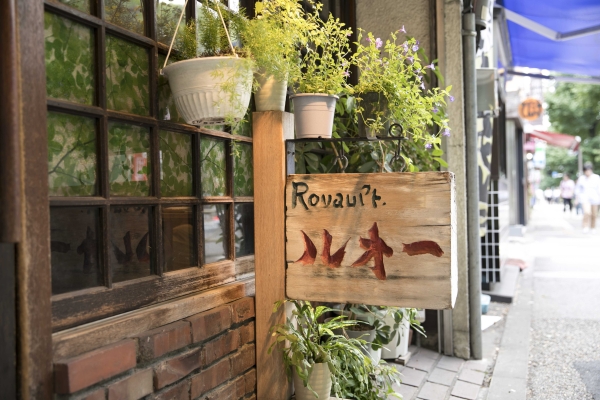
Photo cooperation / Café Rouault
Opened in 1952 as an art gallery café near the Akamon Gate (shop is named after painter Georges Rouault). It was moved to its current location in front of the Main Gate in 1979. The café’s specialty is Ceylon-style curry and rice, which has remained the same since its first opening. The café is decorated with works by local artists, including an entrance sign featuring a cat, a diorama with cats, as well as paintings of cats inside the shop.
Hongo 6-1-14, Bunkyo-ku, Tokyo (along Hongo-dori Avenue)
Photos: Junichi Kaizuka
* This interview was originally printed in Tansei 37 (Japanese language only). All information in this article is as of September 2018.






